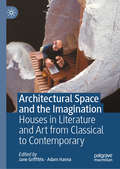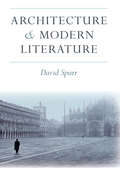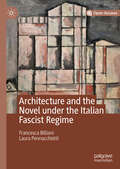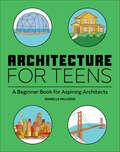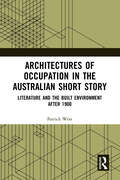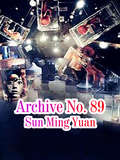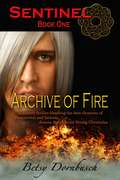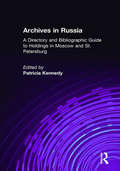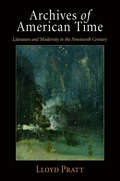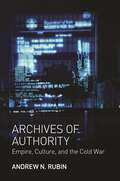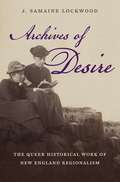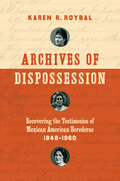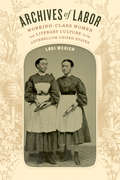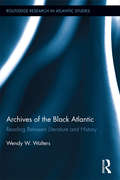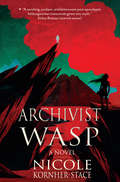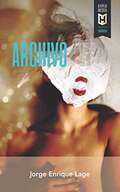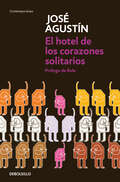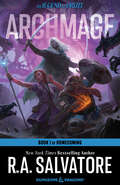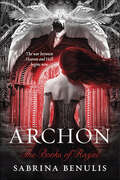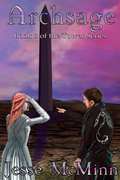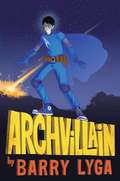- Table View
- List View
Architectural Space and the Imagination: Houses in Literature and Art from Classical to Contemporary
by Adam Hanna Jane GriffithsThis book sheds light on the intimate relationship between built space and the mind, exploring the ways in which architecture inhabits and shapes both the memory and the imagination. Examining the role of the house, a recurrent, even haunting, image in art and literature from classical times to the present day, it includes new work by both leading scholars and early career academics, providing fresh insights into the spiritual, social, and imaginative significances of built space. Further, it reveals how engagement with both real and imagined architectural structures has long been a way of understanding the intangible workings of the mind itself.
Architecture and Modern Literature
by David SpurrArchitecture and Modern Literature explores the representation and interpretation of architectural space in modern literature from the early nineteenth century to the present, with the aim of showing how literary production and architectural construction are related as cultural forms in the historical context of modernity. In addressing this subject, it also examines the larger questions of the relation between literature and architecture and the extent to which these two arts define one another in the social and philosophical contexts of modernity. Architecture and Modern Literature will serve as a foundational introduction to the emerging interdisciplinary study of architecture and literature. David Spurr addresses a broad range of material, including literary, critical, and philosophical works in English, French, and German, and proposes a new historical and theoretical overview of this area, in which modern forms of "meaning" in architecture and literature are related to the discourses of being, dwelling, and homelessness.
Architecture and the Novel under the Italian Fascist Regime
by Francesca Billiani Laura PennacchiettiArchitecture and the Novel under the Italian Fascist Regime discusses the relationship between the novel and architecture during the Fascist period in Italy (1922-1943). By looking at two profoundly diverse aesthetic phenomena within the context of the creation of a Fascist State art, Billiani and Pennacchietti argue that an effort of construction, or reconstruction, was the main driving force behind both projects: the advocated “revolution” of the novel form (realism) and that of architecture (rationalism). The book is divided into seven chapters, which in turn analyze the interconnections between the novel and architecture in theory and in practice. The first six chapters cover debates on State art, on the novel and on architecture, as well as their historical development and their unfolding in key journals of the period. The last chapter offers a detailed analysis of some important novels and buildings, which have in practice realized some of the key principles articulated in the theoretical disputes.
Architecture for Teens: A Beginner's Book for Aspiring Architects
by Danielle WillkensA practical introduction to architecture for aspiring teen architectsArchitecture is a fascinating, diverse field that blends technology, creativity, engineering, and even psychology. Discover the possibilities with this in-depth choice in architecture books for teens. Delve into the world of architecture, learn about recent innovations in sustainability and inclusivity, and uncover the details behind real architectural projects.Explore an overview of architectural movements and designers from prehistory to modern-day, and check out inspiring interviews with working professionals. With tons of practical advice for pursuing a career, you'll find out how you can become an architect and help build an environmentally responsible world from the ground up!Go beyond other architecture books for teens with:Architecture essentials—Get to know the five basic elements of architecture: structure, program, economics, aesthetics, and region.Creative career options—Learn what it means to work in residential or industrial architecture, specialize in historic preservation, create landscapes, innovate in urban planning, and more.Real-world examples—Go behind the scenes on real architectural projects with colorful illustrations, breakdowns of the design process, and thoughtful examinations of their impact.This book makes an excellent choice for Christmas gifts for teens, offering a unique blend of education and inspiration. It's also perfect as a stocking stuffer for teens who are curious about the world of architecture!
Architectures of Occupation in the Australian Short Story: Literature and the Built Environment after 1900
by Patrick WestPatrick West’s Architectures of Occupation in the Australian Short Story cultivates the potential for literary representations of architectural space to contribute to the development of a contemporary politics of Australian post-colonialism.West argues that the predominance of tropes of place within cultural and critical expressions of Australian post-colonialism should be re-balanced through attention to spatial strategies of anti-colonial power. To elaborate the raw material of such strategies, West develops interdisciplinary close readings of keynote stories within three female-authored, pan-twentieth century, Australian short-story collections: Bush Studies by Barbara Baynton (1902); Kiss on the Lips and Other Stories by Katharine Susannah Prichard (1932); and White Turtle: A Collection of Short Stories by Merlinda Bobis (1999). The capacity of the short-story form to prompt creative and politically germinal engagements with species of space associated with architecture and buildings is underscored. Relatedly, West argues that the recent resurgence of binary thought—on local, national, and international scales—occasions an approach to the short-story collections shaped by binary relationships like a dichotomy of inside and outside. Concluding his argument, West connects the literary and architectural critiques of the story collections to the wicked problem, linked to ongoing colonial violences, of improving Australian Indigenous housing outcomes.Innovative and interdisciplinary, this book will be of interest to scholars and students of Literary, Architectural, and Postcolonial Studies. .
Archive No. 89: Volume 1 (Volume 1 #1)
by Sun MingYuanA woman's head soaked in formalin was accidentally found by Tang Doberman, the head of the police officer. As a police officer, he intended to investigate the matter, and as the police officers continued to obstruct him, he fell deeper and deeper into the darkness was spreading. How could he reverse the shocking murder caused by a head? [Previous Chapter] [Table of Contents] [Next Chapter] Reader: 189081841
Archive No. 89: Volume 2 (Volume 2 #2)
by Sun MingYuanA woman's head soaked in formalin was accidentally found by Tang Doberman, the head of the police officer. As a police officer, he intended to investigate the matter, and as the police officers continued to obstruct him, he fell deeper and deeper into the darkness was spreading. How could he reverse the shocking murder caused by a head?
Archive No. 89: Volume 3 (Volume 3 #3)
by Sun MingYuanA woman's head soaked in formalin was accidentally found by Tang Doberman, the head of the police officer. As a police officer, he intended to investigate the matter, and as the police officers continued to obstruct him, he fell deeper and deeper into the darkness was spreading. How could he reverse the shocking murder caused by a head?
Archive of Fire
by Betsy DornbuschTwins Aidan and Kaelin didn't realize until they got to university that most guys don't learn five ways to kill a man by the age of fourteen. Still, since their estranged father descends from the demon Asmodai, it's probably worth knowing how to defend themselves. But as years pass and threat never materializes, the twins suppose their mom is just paranoid - until she disappears. Their father tells them Asmodai has taken possession of their mother in order to infiltrate Sentinel, a treacherous coalition of demidemon rebels determined to protect humankind from the demon legions. The twins form a grudging alliance with Sentinel to rescue her, but when Asmodai murders their father to incite war, Sentinel starts to implode and Aidan and Kaelin must battle an enemy who wears their mother's face.
Archive of Unknown Universes: A Novel
by Ruben Reyes Jr.From the critically acclaimed author of There Is a Rio Grande in Heaven, a piercing debut novel following two families in alternative timelines of the Salvadoran civil war—a stunning exploration of the mechanisms of fate, the gravity of the past, and the endurance of love."Beautiful." —LA Times, A Must-Read Book for Summer "Luminous." —People, A Best Book of July Cambridge, 2018. Ana and Luis’s relationship is on the rocks, despite their many similarities, including their mothers who both fled El Salvador during the war. In her search for answers, and against her best judgement, Ana uses The Defractor, an experimental device that allows users to peek into alternate versions of their lives. What she sees leads her and Luis on a quest through Havana and San Salvador to uncover the family histories they are desperate to know, eager to learn if what might have been could fix what is.Havana, 1978. The Salvadoran war is brewing, and Neto, a young revolutionary with a knack for forging government papers, meets Rafael at a meeting for the People's Revolutionary Army. The two form an intense and forbidden love, shedding their fake names and revealing themselves to each other inside the covert world of their activism. When their work separates them, they begin to exchange weekly letters, but soon, as the devastating war rages on, forces beyond their control threaten to pull them apart forever.Ruben Reyes Jr.’s debut novel is an epic, genre-bending journey through inverted worlds—one where war ends with a peace treaty, and one where it ends with a decisive victory by the Salvadoran government. What unfolds is a stunning story of displacement and belonging, of loss and love. It’s both a daring imagining of what might have been and a powerful reckoning of our past.
Archives in Russia: A Directory and Bibliographic Guide to Holdings in Moscow and St.Petersburg
by Patricia Kennedy Grimsted Patricia Kennedy GrimsteadThis is a comprehensive directory and bibliographic guide to Russian archives and manuscript repositories in the capital cities of Moscow and St. Petersburg. It is an essential resource for any researcher interested in Russian sources for topics in diplomatic, military, and church history; art; dance; film; literature; science; ethnolography; and geography. The first part lists general bibliographies of relevant reference literature, directories, bibliographic works, and specialized subject-related sources. In the following sections of the directory, archival listings are grouped in institutional categories. Coverage includes federal, ministerial, agency, presidential, local, university, Academy of Sciences, organizational, library, and museum holdings. Individual entries include the name of the repository (in Russian and English), basic information on location, staffing, institutional history, holdings, access, and finding aids.More comprehensive and up-to-date than the 1997 Russian Version, this edition includes Web-site information, dozens of additional repositories, several hundred more bibliographical entries, coverage of reorganization issues, four indexes, and a glossary.
Archives of American Time
by Lloyd PrattAmerican historians have typically argued that a shared experience of time worked to bind the antebellum nation together. Trains, technology, and expanding market forces catapulted the United States into the future on a straight line of progressive time. The nation's exceedingly diverse population could cluster around this common temporality as one forward-looking people.In a bold revision of this narrative, Archives of American Time examines American literature's figures and forms to disclose the competing temporalities that in fact defined the antebellum period. Through discussions that link literature's essential qualities to social theories of modernity, Lloyd Pratt asserts that the competition between these varied temporalities forestalled the consolidation of national and racial identity. Paying close attention to the relationship between literary genre and theories of nationalism, race, and regionalism, Archives of American Time shows how the fine details of literary genres tell against the notion that they helped to create national, racial, or regional communities. Its chapters focus on images of invasive forms of print culture, the American historical romance, African American life writing, and Southwestern humor. Each in turn revises our sense of how these images and genres work in such a way as to reconnect them to a broad literary and social history of modernity. At precisely the moment when American authors began self-consciously to quest after a future in which national and racial identity would reign triumphant over all, their writing turned out to restructure time in a way that began foreclosing on that particular future.
Archives of Authority: Empire, Culture, and the Cold War (Translation/Transnation #32)
by Andrew N. RubinCombining literary, cultural, and political history, and based on extensive archival research, including previously unseen FBI and CIA documents, Archives of Authority argues that cultural politics--specifically America's often covert patronage of the arts--played a highly important role in the transfer of imperial authority from Britain to the United States during a critical period after World War II. Andrew Rubin argues that this transfer reshaped the postwar literary space and he shows how, during this time, new and efficient modes of cultural transmission, replication, and travel--such as radio and rapidly and globally circulated journals--completely transformed the position occupied by the postwar writer and the role of world literature. Rubin demonstrates that the nearly instantaneous translation of texts by George Orwell, Thomas Mann, W. H. Auden, Richard Wright, Mary McCarthy, and Albert Camus, among others, into interrelated journals that were sponsored by organizations such as the CIA's Congress for Cultural Freedom and circulated around the world effectively reshaped writers, critics, and intellectuals into easily recognizable, transnational figures. Their work formed a new canon of world literature that was celebrated in the United States and supposedly represented the best of contemporary thought, while less politically attractive authors were ignored or even demonized. This championing and demonizing of writers occurred in the name of anti-Communism--the new, transatlantic "civilizing mission" through which postwar cultural and literary authority emerged.
Archives of Conjure: Stories of the Dead in Afrolatinx Cultures (Gender, Theory, and Religion)
by Solimar OteroIn Afrolatinx religious practices such as Cuban Espiritismo, Puerto Rican Santería, and Brazilian Candomblé, the dead tell stories. Communicating with and through mediums’ bodies, they give advice, make requests, and propose future rituals, creating a living archive that is coproduced by the dead. In this book, Solimar Otero explores how Afrolatinx spirits guide collaborative spiritual-scholarly activist work through rituals and the creation of material culture. By examining spirit mediumship through a Caribbean cross-cultural poetics, she shows how divinities and ancestors serve as active agents in shaping the experiences of gender, sexuality, and race.Otero argues that what she calls archives of conjure are produced through residual transcriptions or reverberations of the stories of the dead whose archives are stitched, beaded, smoked, and washed into official and unofficial repositories. She investigates how sites like the ocean, rivers, and institutional archives create connected contexts for unlocking the spatial activation of residual transcriptions. Drawing on over ten years of archival research and fieldwork in Cuba, Otero centers the storytelling practices of Afrolatinx women and LGBTQ spiritual practitioners alongside Caribbean literature and performance. Archives of Conjure offers vital new perspectives on ephemerality, temporality, and material culture, unraveling undertheorized questions about how spirits shape communities of practice, ethnography, literature, and history and revealing the deeply connected nature of art, scholarship, and worship.
Archives of Desire
by J. Samaine LockwoodIn this thought-provoking study of nineteenth-century America, J. Samaine Lockwood offers an important new interpretation of the literary movement known as American regionalism. Lockwood argues that regionalism in New England was part of a widespread woman-dominated effort to rewrite history. Lockwood demonstrates that New England regionalism was an intellectual endeavor that overlapped with colonial revivalism and included fiction and history writing, antique collecting, colonial home restoration, and photography. The cohort of writers and artists leading this movement included Sarah Orne Jewett, Alice Morse Earle, and C. Alice Baker, and their project was taken up by women of a younger generation, such as Charlotte Perkins Gilman and Pauline Elizabeth Hopkins, who extended regionalism through the modernist moment. Lockwood draws on a diverse archive that includes fiction, material culture, collecting guides, and more. Showing how these women intellectuals aligned themselves with a powerful legacy of social and cultural dissent, Lockwood reveals that New England regionalism performed queer historical work, placing unmarried women and their myriad desires at the center of both regional and national history.
Archives of Dispossession: Recovering the Testimonios of Mexican American Herederas, 1848–1960 (Gender and American Culture)
by Karen R. RoybalOne method of American territory expansion in the U.S.-Mexico borderlands was the denial of property rights to Mexican landowners, which led to dispossession. Many historical accounts overlook this colonial impact on Indigenous and Mexican peoples, and existing studies that do tackle this subject tend to privilege the male experience. Here, Karen R. Roybal recenters the focus of dispossession on women, arguing that gender, sometimes more than race, dictated legal concepts of property ownership and individual autonomy. Drawing on a diverse source base—legal land records, personal letters, and literature—Roybal locates voices of Mexican American women in the Southwest to show how they fought against the erasure of their rights, both as women and as landowners. Woven throughout Roybal's analysis are these women's testimonios—their stories focusing on inheritance, property rights, and shifts in power. Roybal positions these testimonios as an alternate archive that illustrates the myriad ways in which multiple layers of dispossession—and the changes of property ownership in Mexican law—affected the formation of Mexicana identity.
Archives of Labor: Working-Class Women and Literary Culture in the Antebellum United States
by Lori MerishIn Archives of Labor, Lori Merish establishes working-class women as significant actors within literary culture, dramatically redrawing the map of nineteenth-century US literary and cultural history. Delving into previously unexplored archives of working-class women's literature—from autobiographies, pamphlet novels, and theatrical melodrama to seduction tales and labor periodicals—Merish recovers working-class women's vital presence as writers and readers in the antebellum era. Her reading of texts by a diverse collection of factory workers, seamstresses, domestic workers, and prostitutes boldly challenges the purportedly masculine character of class dissent during this era. Whether addressing portrayals of white New England "factory girls," fictional accounts of African American domestic workers, or the first-person narratives of Mexican women working in the missions of Mexican California, Merish unsettles the traditional association of whiteness with the working class to document forms of cross-racial class identification and solidarity. In so doing, she restores the tradition of working women's class protest and dissent, shows how race and gender are central to class identity, and traces the ways working women understood themselves and were understood as workers and class subjects.
Archives of the Black Atlantic: Reading Between Literature and History
by Wendy W. WaltersMany African diasporic novelists and poets allude to or cite archival documents in their writings, foregrounding the elements of archival research and data in their literary texts, and revising the material remnants of the archive. This book reads black historical novels and poetry in an interdisciplinary context, to examine the multiple archives that have produced our historical consciousness. In the history of African diaspora literature, black writers and intellectuals have led the way for an analysis of the archive, querying dominant archives and revising the ways black people have been represented in the legal and hegemonic discourses of the west. Their work in genres as diverse as autobiography, essay, bibliography, poetry, and the novel attests to the centrality of this critique in black intellectual culture. Through literary engagement with the archives of the slave trader, colonizer, and courtroom, creative writers teach us to read the archives of history anew, probing between the documents for stories left untold, questions left unanswered, and freedoms enacted against all odds. Opening new perspectives on Atlantic history and culture, Walters generates a dialogue between what was and what might have been. Ultimately, Walters argues that references to archival documents in black historical literature introduce a new methodology for studying both the archive and literature itself, engaging in a transnational and interdisciplinary reading that exposes the instability of the archive's truth claim and highlights rebellious possibility.
Archivist Wasp
by Nicole Kornher-StaceWasp's job is simple. Hunt ghosts. And every year she has to fight to remain Archivist. Desperate and alone, she strikes a bargain with the ghost of a supersoldier. She will go with him on his underworld hunt for the long-long ghost of his partner and in exchange she will find out more about his pre-apocalyptic world than any Archivist before her. And there is much to know. After all, Archivists are marked from birth to do the holy work of a goddess. They're chosen. They're special. Or so they've been told for four hundred years.Archivist Wasp fears she is not the chosen one, that she won't survive the trip to the underworld, that the brutal life she has escaped might be better than where she is going. There is only one way to find out.
Archivo
by Jorge Enrique LageEn una Cuba distópica, como la que siempre narra Lage, los personajes (modelos con pseudónimos reguetoneros, vírgenes de la Caridad del Cobre robóticas, médiums que localizan fantasmas de agentes de la CIA o del G-2, travestis que quieren imponerse la heterosexualidad, gossipgirls o chivatazzis, es decir, mezclas de chivatas y paparazzis) escenifican la debacle de una civilización basada en la delación y el escarnio. Rafael Rojas Archivo es una novela performativa: enuncia desde la corporalidad. Lage pone a gozar nuestro cuerpo disciplinado. En un mundo heterotópico se exhibe la fantasmagórica vida de enseres, pacientes, vigilantes y bacterias. Debería existir únicamente este tipo de novela, tan excitante y triste como La Habana. Martha Luisa Hernández Cadenas Un buen archivo tiene dosis inexactas de terror, diversión y discapacidad. El de Jorge Enrique Lage me hizo llamar al Rescue a las dos de la madrugada. Legna Rodríguez Iglesias
Archivo José Agustín: Y otros (muchos) textos sobre rock.
by José Agustín"José Agustín es una de las más notables manifestaciones del rock mexicano, probablemente mucho más potente y más significativa que buena parte de las bandas que han surgido en este país" RULO, tomado del prólogo José Agustín es una de las plumas más potentes de la literatura mexicana, representante de una generación de escritores cuyas letras fueron el instrumento ideal para dar voz a una época marcada por el rock, la psicodelia y el relajo. Este volumen, primero de una serie de textos poco conocidos del autor, reúne crónicas y ensayos de José Agustín. Del blues del Misisipi a las tornamesas de Tijuana, de la melancolía de José Alfredo al cine de Orson Welles, José Agustín explora con su libertad y estilo característicos los derroteros de la música, las letras y, por qué no, del cine para ofrecer al lector un atisbo a su visión personalísima del mundo. El resultado es un libro ecléctico y desmadroso, cuyo eje es la pasión incansable que su autor tiene por la música y la palabra.
Archmage: The Legend of Drizzt (The Legend of Drizzt #31)
by R. A. SalvatoreIn the aftermath of the War of the Silver Marches, the combatants take stock as a new tale begins in the Legend of Drizzt seriesThe pall that had descended over the North is gone, and a new day has dawned on a victorious Mithral Hall. But no matter how bright things seem on the surface, Drizzt and his companions know that what lurks just under their feet remains steeped in evil and charged with unimaginable power. The dark elves of Menzoberranzan, including the powerful Archmage Gromph, aren't done with Drizzt yet. And consumed by their own power struggles, feeling backed into a corner, the drow may just be desperate enough to call on demonic forces from the deepest reaches of the Abyss, and unleash a disaster even the Underdark could never have prepared for. Archmage is the first book in the Homecoming trilogy and the thirty-first book in the Legend of Drizzt series.
Archon: The Books Of Raziel (The Books of Raziel #1)
by Sabrina BenulisAngels and demons do battle for a girl possessed by the spirit of a powerful, dead angel in this fabulous paranormal debut by Sabrina Benulis. Archon is the first of the Books of Raziel, a truly fantastic and very hip new take on heaven’s warriors that readers of the angelic novels of Danielle Trussoni, Lauren Kate, Becca Fitzpatrick, and Alexandra Adornetto are sure to adore. Archon is new wave urban fantasy, a tale of the supernatural that brilliantly blends passion, obsession, horror, and suspense in a way that will appeal to dark fantasy fans and paranormal romance readers equally. Sabrina Benulis’s angels are creepy, sexy, and totally awesome—and, like Anne Rice’s amoral, ambiguous, and addicting vampires, they will seduce and terrify you at the same time.
Archsage (Tower)
by Jesse McMinnKyle Campbell is a vagrant, a traveller between worlds who has found himself trapped in the strange and magical land of Loria. In this world, his power is boundless; but his arrival has attracted the attention of dangerous enemies, and Kyle wants nothing more than to return to the world where he belongs.After earning the favor of the Buorish king and barely escaping the wrath of twin assassins Lian and Lacaster, Kyle learns the identity of the one person in Loria who can help him find a way back home: a figure forgotten by time, known only as the Archsage.In order to hold counsel with the Archsage, Kyle and his companions must travel to the very ends of the earth and brave the wilderlands of Westia, the harshest continent on the planet. But they have little choice; Kyle's homeworld is calling to him, and his time in Loria is running out.The final chapter of Kyle's story has begun.
Archvillain
by Barry LygaKyle Camden knows exactly where he was the night Mighty Mike arrived: sneaking around the fallow field behind Bouring Middle School (motto: "The U Makes It Exciting!"), running the electrical cabling that would allow him to dump the contents of the old water tower on the visiting football team during the next day's game. Which is why he couldn't tell anyone where he was. Or what he saw. Those lights everyone witnessed in the sky weren't tiny meteors burning up in the atmosphere. They were some kind of strange supercooled plasma that bathed the entire field--including Kyle--in alien energies, energies that boosted Kyle's intellect and gave him superpowers. Unfortunately, the energies also brought Mighty Mike to earth. Kyle is the only one who knows that Mighty Mike is a space alien. Everyone else thinks that Mike is just some kid who stumbled into the field, got beefed up on meteor juice, lost his memory, and decided to start rescuing kittens from trees. But Kyle knows the truth. And he'll do anything in his power to stop Mighty Mike--even if it means being an archvillain!
